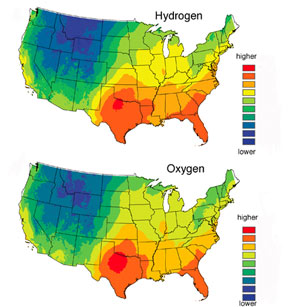|
NEWS NOTES
You are what you drink
| The maps show average predicted hydrogen (top) and oxygen (bottom) isotope levels in human hair. The ratios of heavy, rare isotopes to lighter, common isotopes are highest in red and orange areas and lowest in the blue and darker green areas. |
When a pair of hunters found the young woman known only as “Saltair Sally” on the south shore of the Great Salt Lake in 2000, all that was left were 26 bones, a beaded choker and a mass of curly brown hair. Eight years later, she has yet to be identified. But by analyzing a few strands of Sally’s hair, researchers at the University of Utah in Salt Lake City may have uncovered where she lived before she died — a clue that could help officials finally determine her identity.
All water is made of hydrogen and oxygen, but not all atoms of hydrogen or oxygen are the same. Different isotopes — with different atomic weights — appear in different concentrations depending on where the water is collected. Water in southern Oklahoma, for instance, contains more heavy isotopes than water from northern Montana. And because we drink the water where we live, there is evidence of those geographical differences in our muscles, bones, fingernails and even our hair, a team of researchers suggests Feb. 26 in Proceedings of the National Academy of Sciences.
To test the idea, the researchers collected hair clippings from barbershops in 65 cities scattered across 18 U.S. states and compared the isotopes found in the hair to the isotopes found in samples of the local tap water. They observed a clear relationship — but the concentrations of isotopes found in the tap water didn’t exactly match those found in the hair. “They’re related to each other, but it’s not a one-to-one relationship,” says James Ehleringer, an environmental chemist at the University of Utah. In fact, Ehleringer and his team found that only 27 percent of the hydrogen and 35 percent of the oxygen could be directly linked to drinking water.
That’s because we’re on what Ehleringer and his colleagues call “the supermarket diet” — much of what we eat and drink isn’t really local. A cucumber raised in California, for instance, will contain water from California. Wine, beer and fresh juice are often from far away too. And that throws off the isotope concentrations in our hair. But the researchers point out that we boil pasta in local water, pour local milk onto our cereal, and drink sodas that are often bottled locally. And those inputs leave their mark.
To explain the relationship between hair isotopes and drinking water isotopes, the team developed a model, which takes into account the supermarket diet to predict what isotope concentrations would be present in the hair of people from various regions. They then used a new set of hair samples to challenge their model, running it in reverse to predict where people lived based on the isotopes found in their hair. “Eighty-five percent of the time, when we predicted a region, we were correct,” Ehleringer says.
“This is a terrific dataset,” says Stephen Macko, a geochemist at the University of Virginia in Charlottesville. But, he adds, “there’s a real need for additional testing of this under controlled conditions.” Macko says that much of the literature to date suggests that “you are what you eat, not what you drink.” So the fact that Ehleringer’s team found a strong relationship between the isotopes in people’s hair and the isotopes in their water is surprising, he says. “I would not have expected such a good correlation.”
The model can’t pinpoint a city or a county, only a region. All that researchers can say about Saltair Sally, for instance, is that she had been living somewhere between Salt Lake City, Utah, and Great Falls, Mont., when she died in the late 1990s. And she was a drifter: Sally’s hair was long enough for the researchers to trace her movements for the last two years of her life. But that’s valuable information, especially in the realm of unidentified remains, says Todd Park, the detective at the Salt Lake County Sheriff’s Office tasked with uncovering Sally’s identity. “It makes it much more manageable,” he says. Imagine you lost your car keys, but you know they’re in the kitchen. “You don’t have to search the rest of the house,” Park says.

 Subscribe
Subscribe



